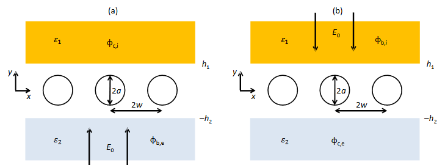First Principles Model of Electric Cable Braid Penetration with Dielectrics
Abstract
In this study, we report the formulation to account for dielectrics in a first principles multipole-based cable braid electromagnetic penetration model. To validate our first principles model, we consider a one-dimensional array of wires, which can be modeled analytically with a multipole-conformal mapping expansion for the wire charges; however, the first principles model can be readily applied to realistic cable geometries. We compare the elastance (i.e. the inverse of the capacitance) results from the first principles cable braid electromagnetic penetration model to those obtained using the analytical model. The results are found in good agreement up to a radius to half spacing ratio of 0.5-0.6, depending on the permittivity of the dielectric used, within the characteristics of many commercial cables. We observe that for typical relative permittivities encountered in braided cables, the transfer elastance values are essentially the same as those of free space; the self-elastance values are also approximated by the free space solution as long as the dielectric discontinuity is taken into account for the planar mode.
- Authors:
-
- Sandia National Lab. (SNL-NM), Albuquerque, NM (United States)
- Publication Date:
- Research Org.:
- Sandia National Lab. (SNL-NM), Albuquerque, NM (United States)
- Sponsoring Org.:
- USDOE National Nuclear Security Administration (NNSA)
- OSTI Identifier:
- 1457365
- Report Number(s):
- SAND-2018-0824J
Journal ID: ISSN 1937-8718; 660395
- Grant/Contract Number:
- AC04-94AL85000
- Resource Type:
- Accepted Manuscript
- Journal Name:
- Progress in Electromagnetics Research C
- Additional Journal Information:
- Journal Volume: 82; Journal ID: ISSN 1937-8718
- Publisher:
- EMW Publishing
- Country of Publication:
- United States
- Language:
- English
- Subject:
- 42 ENGINEERING; electric penetration; dielectrics; first principles electromagnetic penetration model; cable braid
Citation Formats
Campione, Salvatore, Warne, Larry Kevin, Langston, William L., and Basilio, Lorena I. First Principles Model of Electric Cable Braid Penetration with Dielectrics. United States: N. p., 2018.
Web. doi:10.2528/pierc17103010.
Campione, Salvatore, Warne, Larry Kevin, Langston, William L., & Basilio, Lorena I. First Principles Model of Electric Cable Braid Penetration with Dielectrics. United States. https://doi.org/10.2528/pierc17103010
Campione, Salvatore, Warne, Larry Kevin, Langston, William L., and Basilio, Lorena I. Mon .
"First Principles Model of Electric Cable Braid Penetration with Dielectrics". United States. https://doi.org/10.2528/pierc17103010. https://www.osti.gov/servlets/purl/1457365.
@article{osti_1457365,
title = {First Principles Model of Electric Cable Braid Penetration with Dielectrics},
author = {Campione, Salvatore and Warne, Larry Kevin and Langston, William L. and Basilio, Lorena I.},
abstractNote = {In this study, we report the formulation to account for dielectrics in a first principles multipole-based cable braid electromagnetic penetration model. To validate our first principles model, we consider a one-dimensional array of wires, which can be modeled analytically with a multipole-conformal mapping expansion for the wire charges; however, the first principles model can be readily applied to realistic cable geometries. We compare the elastance (i.e. the inverse of the capacitance) results from the first principles cable braid electromagnetic penetration model to those obtained using the analytical model. The results are found in good agreement up to a radius to half spacing ratio of 0.5-0.6, depending on the permittivity of the dielectric used, within the characteristics of many commercial cables. We observe that for typical relative permittivities encountered in braided cables, the transfer elastance values are essentially the same as those of free space; the self-elastance values are also approximated by the free space solution as long as the dielectric discontinuity is taken into account for the planar mode.},
doi = {10.2528/pierc17103010},
journal = {Progress in Electromagnetics Research C},
number = ,
volume = 82,
place = {United States},
year = {Mon Jan 01 00:00:00 EST 2018},
month = {Mon Jan 01 00:00:00 EST 2018}
}
Figures / Tables:
 Fig. 1.: Dielectric materials surround the planar braid layer: (a) excitation from below and (b) excitation from above. Φci, and Φce, represent the internal and external potentials in the shadow side of the structure, respectively. Φbi, and Φbe, represent the internal and external potentials in the illuminated side of themore »
Fig. 1.: Dielectric materials surround the planar braid layer: (a) excitation from below and (b) excitation from above. Φci, and Φce, represent the internal and external potentials in the shadow side of the structure, respectively. Φbi, and Φbe, represent the internal and external potentials in the illuminated side of themore »
Figures / Tables found in this record:

 Search WorldCat to find libraries that may hold this journal
Search WorldCat to find libraries that may hold this journal